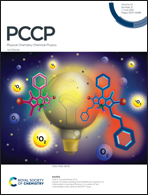Theoretical investigation of defective MXenes as potential electrocatalysts for CO reduction toward C2 products†
Abstract
Electrochemical CO2/CO conversion to valuable chemical products is an attractive strategy for storage of clean energy and control of greenhouse gas emission. Currently, CO2 reduction to CO is relatively mature, whereas the deep reduction and further conversion of CO into multi-carbon products, such as ethylene (C2H4) and ethanol (C2H5OH), are highly challenging. Based on the density functional theory (DFT) calculations, we explored the possibility of CO reduction reaction (CORR), to obtain C2 products, with defective MXenes in which the defect is created by removing two neighboring oxygen atoms on the surface. Our results revealed that the dual-oxygen vacancy in defective Mo2TiC2O2 (labeled as Mo2TiC2O2-2OV) can offer a unique environment that confines and enriches the active *COH species, significantly promoting the reduction process as well as C–C bond coupling. The thermodynamic barrier of the potential-determining step (PDS) for Mo2TiC2O2-2OV is 0.32 eV with promising selectivity of C2 products over the competing hydrogen evolution reaction (HER). This work provides a feasible strategy for designing MXene-based electrocatalysts for highly efficient CO2/CO reduction to C2 products.



 Please wait while we load your content...
Please wait while we load your content...